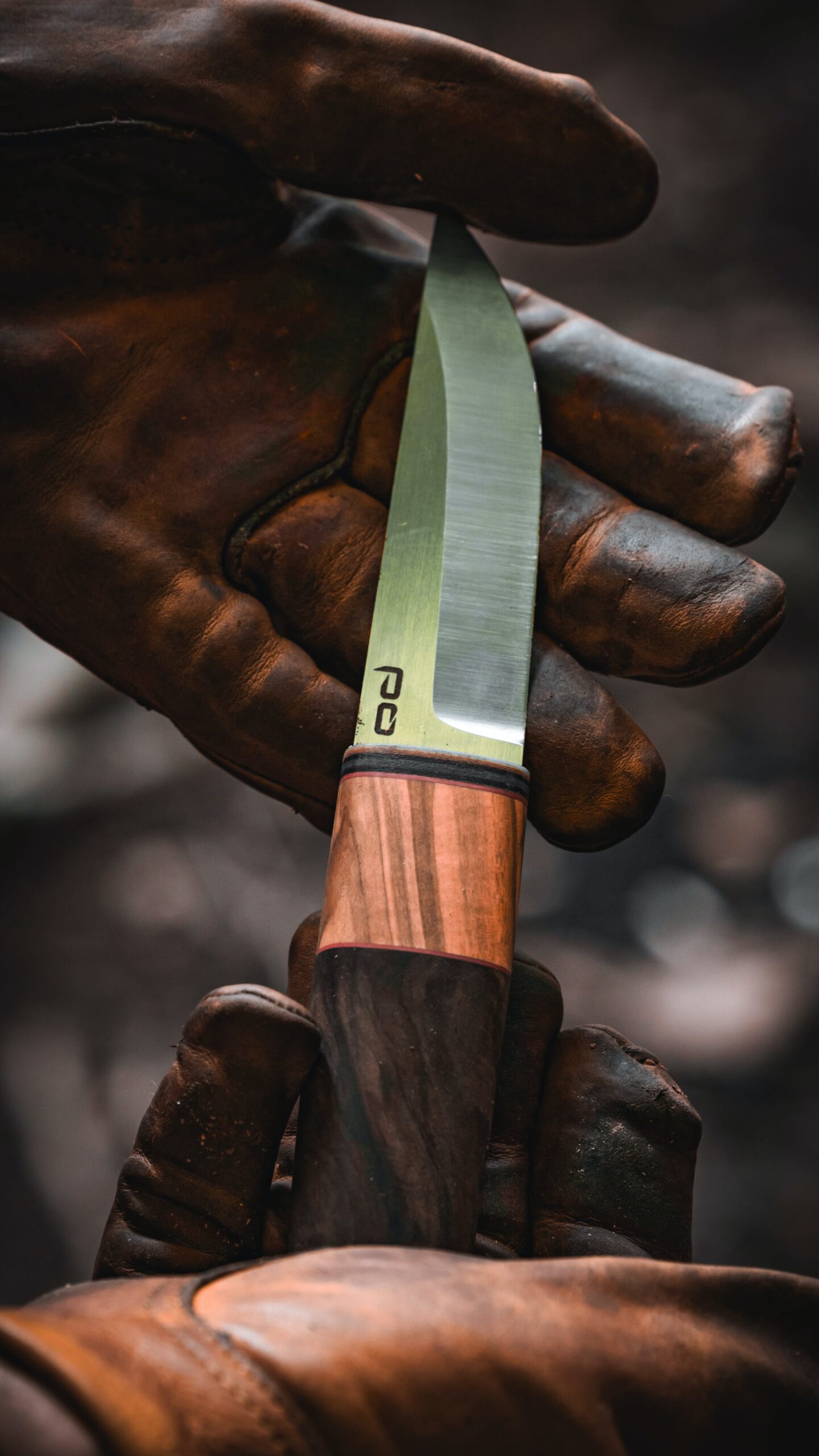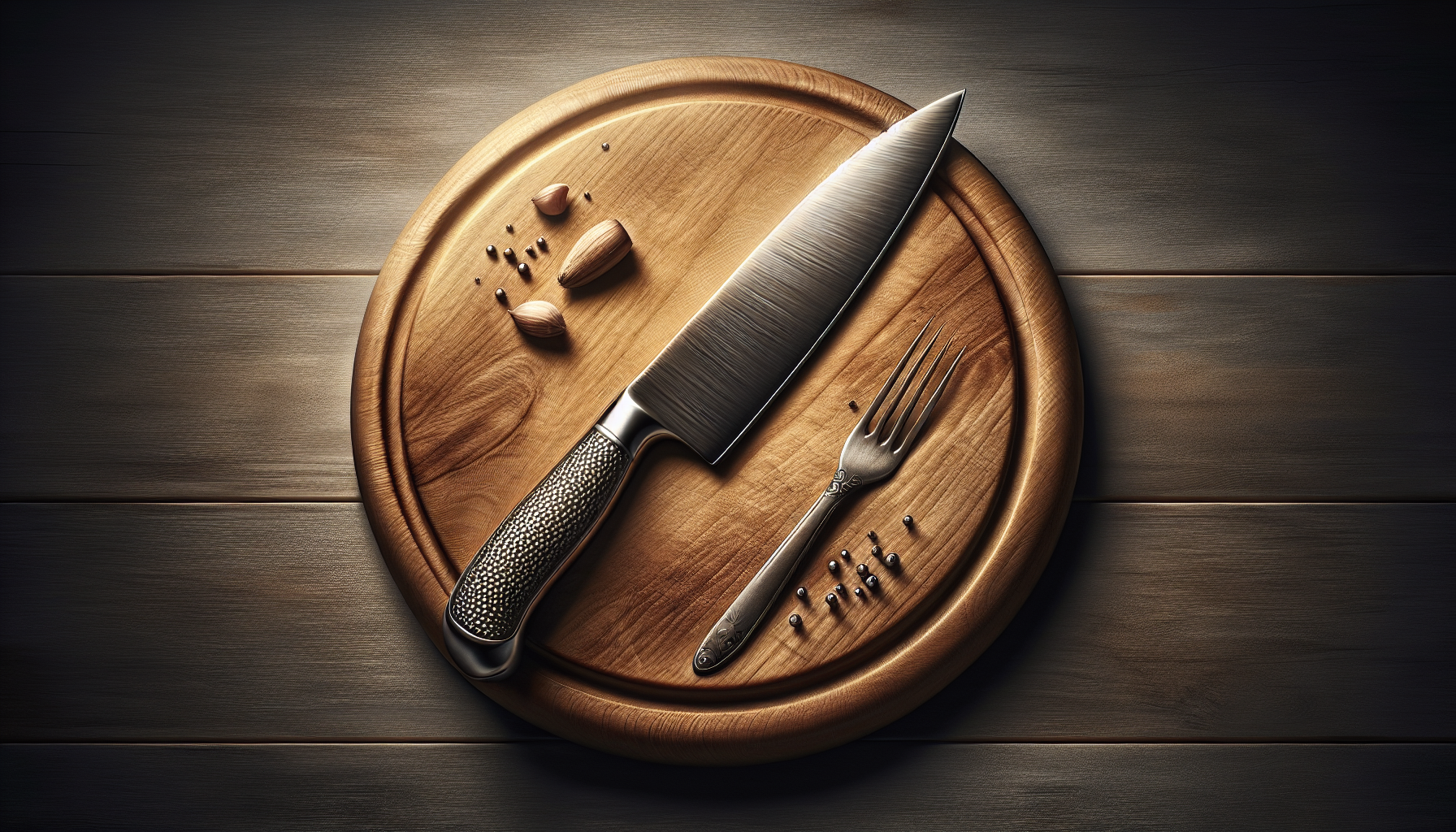In this helpful guide, the focus is on knife maintenance specifically tailored for seniors. As we age, it becomes even more important to ensure that our kitchen tools are in optimal condition to make cooking a breeze. From sharpening techniques to proper storage methods, this article provides valuable tips and insights on how to take care of your knives. With the help of Tastepan’s expertise, you’ll be able to master the art of knife maintenance and ensure your cooking experience is both safe and enjoyable.

Importance of Knife Maintenance
Taking care of your knives is essential for both their longevity and your safety in the kitchen. Proper knife maintenance not only extends the life of your favorite blades but also ensures safe and efficient cutting while preventing bacterial contamination.
Extends the life of the knife
A well-maintained knife can last a lifetime. By regularly cleaning, sharpening, and storing your knives properly, you can prevent damage to the blades and maintain their sharpness. Knives that are neglected can become dull, and, in severe cases, they may even become irreparable. By dedicating a little time to maintenance, you can keep your knives in tip-top shape and avoid the need for frequent replacements.
Ensures safe and efficient cutting
Maintaining sharp and well-functioning knives is crucial for safe and efficient cutting. A dull knife requires more force to cut through food, increasing the risk of slips and accidents. On the other hand, a properly sharpened and maintained knife allows for precise and effortless cutting, reducing the likelihood of injuries. Keeping your knives well-maintained not only protects you but also enhances your overall cooking experience by making your tasks more manageable and enjoyable.
Prevents bacterial contamination
Bacterial contamination is a serious concern in the kitchen, and proper knife maintenance can help prevent its occurrence. When you use a knife to prepare food, bacteria from raw ingredients can easily transfer to the knife’s blade. If not cleaned thoroughly, these bacteria can multiply and contaminate other foods, leading to foodborne illnesses. Regularly cleaning your knives after each use, and ensuring they are completely dry, helps remove food particles and bacteria, reducing the risk of contamination and promoting food safety.
Cleaning Your Knife
Properly cleaning your knife is essential for maintaining its performance and preventing bacterial growth. Here are some tips to keep your knives clean and pristine.
Handwashing vs Dishwasher
Although some knives may claim to be dishwasher-safe, handwashing is generally the best method for cleaning your knives. Dishwashers can be harsh on the blade, causing damage or corrosion over time. It is recommended to wash your knives by hand using mild soap and warm water to preserve their longevity and functionality.
Using mild soap and warm water
When handwashing your knives, use a mild dish soap and warm water. Avoid using abrasive cleaners or scrub brushes, as they can damage the blade’s finish. Gently scrub the knife with a soft sponge or cloth, paying attention to any areas with stubborn residue. Rinse thoroughly to ensure that all soap residue is removed.
Drying the knife properly
After washing, it is crucial to dry your knife immediately and thoroughly. Dampness on the blade can lead to rust or corrosion. Use a clean towel or paper towel to dry the knife, paying extra attention to the blade and handle. Make sure all moisture is removed before storing the knife.
Removing stains and rust
If you notice any stains or rust on your knife, it is important to address the issue promptly. Stains can typically be removed by creating a paste of baking soda and water and gently scrubbing the affected area. For rust, you can use a rust eraser or a mixture of vinegar and water to remove the oxidation. Always follow up with proper cleaning, drying, and oiling to prevent future rusting.

Sharpening Your Knife
Keeping your knife sharp is key to its performance and safety. Dull blades not only make cutting more difficult but also increase the risk of accidents. Here are some tips to help you sharpen your knife effectively.
Frequency of sharpening
The frequency of sharpening your knife depends on how often you use it and the type of blade. As a general rule, most knives benefit from regular sharpening every 3-6 months. However, if you notice a significant decrease in performance or feel the blade is dull, it is best to sharpen it sooner rather than later.
Choosing the right sharpening method
There are various methods to sharpen your knife, including using sharpening stones, honing steels, or electric sharpeners. Each method has its advantages and can be suitable for different knives and user preferences. It is essential to choose the method that works best for you and your knives.
Using a sharpening stone
Sharpening stones, also known as whetstones, provide a traditional and effective way to sharpen your knives. They come in different grit levels, with finer grits ideal for polishing and refining the blade’s edge. Using a lubricant like water or honing oil, place the stone on a stable surface and maintain a consistent angle while sliding the blade across the stone in smooth, controlled motions. Repeat the process on both sides of the blade until the desired sharpness is achieved.
Using a honing steel
Honing steels, or sharpening rods, are used to maintain the edge of a knife between sharpenings. They are excellent for realigning the blade and removing any microscopic burrs that cause the blade to dull. To use a honing steel, hold the steel upright in one hand and the knife in the other hand. Maintain a consistent angle and gently run the blade against the steel in a sweeping motion, alternating sides. Remember, honing steels do not sharpen the blade but help maintain its sharpness.
Storing Your Knife Properly
Proper knife storage not only protects the knife but also keeps you and your loved ones safe from accidental cuts. Here are some tips for storing your knives correctly.
Knife blocks and magnetic strips
Knife blocks and magnetic strips are popular storage options that help keep your knives organized and within easy reach. Knife blocks provide a secure and compact storage solution, with individual slots to hold each knife in place. Magnetic strips, on the other hand, allow the knives to be mounted on a wall or placed on a countertop using strong magnets. Both options keep the blades protected and reduce the risk of accidents when reaching for a knife.
Knife sheaths and blade guards
If you frequently travel with your knives or need extra protection, consider investing in knife sheaths or blade guards. Sheaths are usually made of leather or plastic and provide a cover for the blade, preventing accidental contact and preserving the knife’s sharpness. Blade guards, made of plastic or silicone, slide over the blade to protect both the blade and your hands when the knife is not in use. These storage options are particularly useful when transporting knives or when storing them in drawers.
Avoiding knife drawer storage
Although it may be tempting to store your knives in a kitchen drawer, it is generally not recommended. The blades can become easily damaged by knocking against other utensils or surfaces, leading to dullness or chips. Additionally, reaching into a drawer packed with sharp objects increases the risk of accidental cuts. If drawer storage is your only option, consider using blade guards or individual knife sleeves to protect the blades and yourself.
Considering wall-mounted racks
If you have limited counter space or prefer a more decorative storage option, wall-mounted knife racks can be an excellent choice. These racks allow you to display your knives safely on the wall while freeing up valuable counter space. Ensure the rack is securely mounted and that the knives are attached with strong magnets or individual slots to prevent accidental falls.

Choosing the Right Cutting Board
The choice of cutting board can impact both the longevity of your knives and the safety of your food preparation. Here are some considerations when selecting the right cutting board.
Opting for wood or plastic
Wood and plastic cutting boards are the most common options available, each with its advantages. Wood cutting boards are gentle on the knife blades, reducing the risk of frequent sharpening. They also have natural antimicrobial properties, which can help inhibit the growth of bacteria. Plastic cutting boards, on the other hand, are generally more affordable, easier to clean, and can be placed in the dishwasher. Both options are suitable, so choose the one that aligns with your preferences and needs.
Avoiding glass and marble
While glass and marble cutting boards may be aesthetically pleasing, they are not recommended for knife longevity or food safety. Glass cutting boards often cause excessive wear on knife blades due to their hard surface, leading to dullness or chips. Marble cutting boards, although visually appealing, can damage knives due to their dense and unforgiving nature. It is advisable to avoid these materials to preserve the lifespan of your knives and maintain optimal cutting performance.
Using separate boards for different food groups
To prevent cross-contamination and ensure food safety, using separate cutting boards for different food groups is highly recommended. The FDA recommends using one cutting board for raw meats, another for fruits and vegetables, and a third for cooked foods. This practice helps prevent the transfer of harmful bacteria and reduces the risk of foodborne illnesses. Color-coded cutting boards can be helpful in distinguishing between boards designated for specific food groups.
Proper Knife Handling
Proper knife handling skills are essential for both efficiency and safety in the kitchen. Follow these tips to handle your knives correctly.
Holding the knife correctly
Hold the knife with a firm grip, ensuring your thumb and index finger rest on the blade’s sides for stability and control. The remaining fingers should wrap around the handle securely. Avoid gripping the knife too tightly, as it can hinder your dexterity and lead to fatigue. Practice handling the knife in a balanced and comfortable manner to maintain control during cutting tasks.
Using a cutting technique
Adopting the correct cutting technique can make a significant difference in your efficiency and safety while using a knife. The “claw” grip is a widely recommended technique where you curl your fingertips inward while keeping them away from the blade. This grip aids in guiding the knife and prevents accidental contact with your fingers. Practice proper hand placement and cutting movements to enhance your cutting skills and reduce the risk of injuries.
Avoiding excessive force
A sharp knife should effortlessly glide through food, so avoid using excessive force while cutting. Applying excessive pressure can cause the knife to slip or lead to accidental cuts. Let the sharpness of the blade do the work for you, and allow the weight of the knife to guide the cutting motion. By maintaining a relaxed grip and letting the knife handle most of the work, you can achieve precise and controlled cuts without the need for excessive force.
Keeping fingers away from the blade
One of the fundamental rules of knife safety is to keep your fingers away from the blade’s path while cutting. Curl your fingertips inward and keep them away from the cutting line, using the knuckles as a guide. This technique ensures that your fingers are safe and reduces the risk of accidental cuts. Always pay attention to your hand positioning and maintain a clear awareness of the knife’s blade throughout the cutting process.
Regular Maintenance Routine
Establishing a regular maintenance routine for your knives will help keep them in optimal condition for years to come. Follow these steps to ensure your knives receive the care they deserve.
Inspecting the knife for damage or wear
Regularly inspect your knives for any signs of damage, wear, or loose handles. Inspect the blade for chips, cracks, or bent edges, and check the handles for signs of loosening or splitting. Any signs of damage should be addressed promptly to prevent further deterioration and potential accidents during use. Regular inspections also allow you to catch any issues early on and seek professional assistance if needed.
Sharpening and honing when needed
Pay attention to the sharpness of your knife and sharpen or hone it as needed. If you notice the blade is dull or not performing as desired, it may be time for sharpening. Regular honing, which helps realign the blade and maintain sharpness between sharpenings, should also be part of your maintenance routine. Remember, a sharp knife not only enhances your cutting experience but also reduces the risk of accidents.
Cleaning and drying after each use
After each use, thoroughly clean your knife and ensure it is completely dry before storing. Clean the blade and handle with mild soap and warm water, removing any food particles or residue. Dry the knife immediately using a clean towel or paper towel, paying special attention to the blade. Proper cleaning and drying prevent the buildup of bacteria and protect the knife from moisture-related issues like rust or corrosion.
Dealing with Rust
Rust formation can be a common issue, especially if your knives are not properly cleaned and stored. Here are some tips to help you deal with rust effectively.
Causes of rust formation
Rust forms when moisture comes into contact with the metal of the knife blade. Factors such as improper drying, exposure to acidic or corrosive substances, or the use of abrasive cleaning methods can contribute to rust formation. It is crucial to address these causes and implement proper care techniques to prevent future rusting.
Removing rust from the blade
To remove rust from the blade, you can use various methods depending on the severity of the rust. For light rust, scrub the affected area gently using a rust eraser, a mixture of baking soda and water, or lemon juice. For more stubborn rust, you can soak the blade in vinegar or use a commercial rust remover following the manufacturer’s instructions. After removing the rust, thoroughly clean and dry the knife to prevent its recurrence.
Preventing future rust
Once you have removed the rust from your knife, it is essential to take preventative measures to avoid future rust formation. Clean and dry the knife thoroughly after each use, and consider applying a thin layer of food-grade mineral oil or specialized knife oil to the blade. This protective coating helps repel moisture and prevents the blade from coming into direct contact with water or other corrosive substances.
Safe Knife Storage for Seniors
For seniors, ensuring safe knife storage is particularly important to prevent accidents and injuries. Here are some tips for safe knife storage for seniors.
Placing knives out of reach of children
If there are children in the household, it is essential to keep knives out of their reach. Store knives in a location where children cannot access them, such as in high cabinets or locked drawers. Teaching children about knife safety and the importance of not handling knives without adult supervision is also crucial for their well-being.
Using a knife block with lock or cover
For added safety, consider using a knife block with a lock or cover. These specially designed blocks typically have a locking mechanism or a cover that prevents anyone from accessing the knives without the key or removing the cover. This type of storage option provides an extra layer of protection, especially in homes with curious grandchildren or visitors.
Considering knife safety locks or guards
Knife safety locks or guards can be an additional safety measure, especially for seniors with mobility or hand dexterity issues. These locking mechanisms secure the blade in place, reducing the risk of accidental cuts when retrieving or storing the knife. Consult with a knife professional or explore knife options with built-in safety features to find the best solution for your specific needs.
Tips for Seniors with Arthritis
Arthritis can make handling knives challenging, but there are strategies and tools available to help seniors continue cooking safely and enjoyably.
Choosing knives with ergonomic handles
When selecting knives, prioritize those with ergonomic handles designed to reduce strain on the hands and joints. These handles are typically contoured, providing a comfortable grip and reducing the effort needed for cutting tasks. Look for knives with handles made of materials like rubber or silicone, which offer a secure and non-slip grip for individuals with arthritis.
Using assistive devices for cutting
Assistive devices can offer additional support for seniors with arthritis. Lifting aids, cutting boards with stabilizing pegs, or adaptive cutting utensils can make cutting tasks more manageable. These devices are specifically designed to accommodate individuals with dexterity issues and can help reduce strain on the hands and joints.
Exploring electric knives
Electric knives can be a helpful tool for seniors with arthritis, as they require less effort and pressure to operate. These knives have motorized blades that do the cutting work for you, minimizing the strain on your hands and wrists. Electric knives are particularly useful for slicing through tougher meats or bread, allowing seniors to continue preparing their favorite dishes with ease.
In conclusion, proper knife maintenance is crucial for extending the life of your knives, ensuring safe and efficient cutting, and preventing bacterial contamination. By following these maintenance tips, including cleaning and drying your knives properly, sharpening them when needed, and storing them safely, you can enjoy the benefits of well-maintained knives in your kitchen for years to come. Remember to prioritize safety when handling knives, regularly inspect and address any damage or wear, and take preventative measures to avoid rust formation. For seniors, implementing safe storage practices and utilizing tools or devices designed for arthritis can help maintain both their knife skills and kitchen confidence. With proper maintenance and care, your knives will continue to enhance your culinary experiences and make cooking a breeze.

